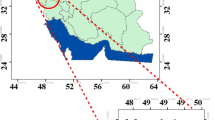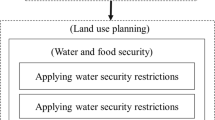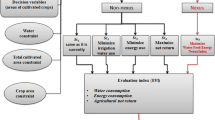Abstract
The evaluation of energy efficiency is a key principle in agroecosystem management. In this article, the optimal cropping pattern of irrigated and rainfed lands in the eastern Lorestan province is proposed using multi-objective nonlinear programming (MOP) to maximize net profit, energy efficiency, and net energy and minimize non-renewable energy and GWP. The results showed that in the MOP pattern, the indirect energy levels of irrigated and rainfed lands decreased by 1.90E+13 and 4.80E+13 J in the study area, respectively; non-renewable energy levels decreased by 3.00E+12 and 3.20E+13 J, respectively; and the GWP levels decreased by 1.00E+06 and 9.00E+05 kg CO2-eq in the region compared to the existing pattern. In the MOP pattern, the energy efficiency of irrigated and rainfed lands increased by 0.20 and 0.19, respectively, compared to the existing state. By implementing the optimal cropping pattern, energy inputs can be reduced by 1.20E+14 J and net profit increased by 968,483 USD. By using the proposed pattern, in addition to selecting the appropriate model and optimizing the use of water and land resources, effective steps can be taken for enhancing the profit and declining the energy consumption and environmental impacts.



Similar content being viewed by others
References
Acosta-Alba I, Chia E, Andrieu N (2019) The LCA4CSA framework: using life cycle assessment to strengthen environmental sustainability analysis of climate smart agriculture options at farm and crop system levels. Agric Syst 171:155–170
Alluvione F, Moretti B, Sacco D, Grignani C (2011) EUE (energy use efficiency) of cropping systems for a sustainable agriculture. Energy 36:4468–4481
Amiri Z, Asgharipour MR, Campbell DE, Armin M (2019) A sustainability analysis of two rapeseed farming ecosystems in Khorramabad, Iran, based on emergy and economic analyses. J Clean Prod 226:1051–1066
Amiri Z, Asgharipour MR, Campbell DE, Azizi K, Kakolvand E, Moghadam EH (2021) Conservation agriculture, a selective model based on emergy analysis for sustainable production of shallot as a medicinal-industrial plant. J Clean Prod 292:126000
Asgharipour MR, Mondani F, Riahinia S (2012) Energy use efficiency and economic analysis of sugar beet production system in Iran: a case study in Khorasan Razavi province. Energy 44(1):1078–1084
Asgharipour MR, Amiri Z, Campbell DE (2020) Evaluation of the sustainability of four greenhouse vegetable production ecosystems based on an analysis of emergy and social characteristics. Ecol Model 424:109021
Aydın B, Aktürk D (2018) Energy use efficiency and economic analysis of peach and cherry production regarding good agricultural practices in Turkey: a case study in Çanakkale province. Energy 158:967–974
Banaeian N, Omid M, Ahmadi H (2016) Energy and economic analysis of greenhouse strawberry production in Tehran province of Iran. Energy Convers Manag 52:1020–1025
Baran MF, Gokdogan O (2016) Determination of energy balance of sugar beet production in Turkey: a case study of Kırklareli Province. Energy Effic 9(2):487–494
Beheshti Tabar I, Keyhani A, Rafiee SH (2010) Energy balance in Iran’s agronomy (1990–2006). Renew Sustain Energ Rev 14:849–855
Berenger V, Verdier-Chouchane A (2007) Multidimensional measures of well-being: standard of living quality of life across countries. World Dev 35:1259–1279
Boustani F, Mohammadi H (2010) Determination of optimal cropping pattern due to water deficit: a case study in the south of Iran. Am Euras J Agric Environ Sci 7(5):591–595
Chakraborty M, Gupta S (2002) Fuzzy mathematical programming for multi objective linear fractional programming problem. Fuzzy Set Sys 125(3):335–342
Cheng LI, Yue WANG, Qiu GY (2013) Water and energy consumption by agriculture in the Minqin Oasis Region. J Integr Agric 12(8):1330–1340
Chiappero ME (1996) Standard of living evaluation based on Sen’s approach: some methodological suggestions. Notizie di Politeia 12:37–53
Chojnacka K, Kowalski Z, Kulczycka J, Dmytryk A, Górecki H, Ligas B, Gramza M (2019) Carbon footprint of fertilizer technologies. J Environ Manag 231:962–967
Colaço AF, Povh FP, Molin JP, Romanelli TL (2012) Energy assessment for variable rate nitrogen application. Int J Agric Eng 14(3):85–90
Cooper JM, Butler G, Leifert C (2011) Life cycle analysis of greenhouse gas emissions from organic and conventional food production systems, with and without bio-energy options. NJAS-WAGEN J Life Sci 58:185–192
Dalgaard T, Halberge N, Porter GR (2001) A model for fossil energy use in Danish agriculture used to compare organic and conventional farming. Agric Ecosyst Environ 87:51–65
de Moraes SJC, Lal R, Cerri CC, Lorenz K, Hungria M, de Faccio CPC (2017) Low-carbon agriculture in South America to mitigate global climate change and advance food security. Environ Int 98:102–112
Delmotte S, Lopez-Ridaura S, Barbier JM, Wery J (2013) Prospective and participatory integrated assessment of agricultural systems from farm to regional scales: comparison of three modeling approaches. J Environ Manag 129:493–502
Dury J, Garcia F, Reynaud A, Bergez JE (2013) Cropping-plan decision-making on irrigated crop farms: a spatio-temporal analysis. Eur J Agron 50:1–10
Eggleston HS, Buendia L, Miwa K, Ngara T, Tanabe K (2006) 2006 IPCC guidelines for national greenhouse gas inventories
Elsoragaby S, Yahya A, Mahadi MR, Nawi NM, Mairghany M (2019) Energy utilization in major crop cultivation. Energy 173:1285–1303
Emamzadeh SM, Forghani MA, Karnema A, Darbandi S (2016) Determining an optimum pattern of mixed planting from organic and non-organic crops with regard to economic and environmental indicators: a case study of cucumber in Kerman. Iran Inf Process Agric 3(4):207–214
Erdal G, Esengu K, Erdal H, Gunduz O (2007) Energy use and economical analysis of sugar beet production in Tokat province of Turkey. Energy 32:35–41
Fallahpour F, Aminghafouri A, Ghalegolab Behbahani A, Bannayan M (2012) The environmental impact assessment of wheat and barley production by using life cycle assessment (LCA) methodology. Environ Dev Sustain 14:979–992
Fasakhodi AA, Nouri SH, Amini M (2010) Water resources sustainability and optimal cropping pattern in farming systems; a multi-objective fractional goal programming approach. Water Resour Manag 24(15):4639–4657
Galán-Martín Á, Pozo C, Guillén-Gosálbez G, Vallejo AA, Esteller LJ (2015) Multi-stage linear programming model for optimizing cropping plan decisions under the new Common Agricultural Policy. Land Use Policy 48:515–524
GAMS/CONOPT4 (2015) GAMS/CONOPT4. Bagsvaerdvej 246A, DK-2880 Bagsvaerd. Arki Consulting Development, Denmark
Ghorbani R, Mondani F, Amirmoradi S, Feizi H, Khorramdel S, Teimouri M, Sanjani S, Anvarkhah S, Aghel H (2011) A case study of energy use and economical analysis of irrigated and dry land wheat production systems. Appl Energy 88:283–288
Goossens Y, Annaert B, De Tavernier J, Mathijs E, Keulemans W, Geeraerd A (2017) Life cycle assessment (LCA) for apple orchard production systems including low and high productive years in conventional, integrated and organic farms. Agric Syst 153:81–93
Groot JC, Oomen GJ, Rossing WA (2012) Multi-objective optimization and design of farming systems. Agric Syst 110:63–77
Heidari H, Katircioğlu ST, Saeidpour L (2015) Economic growth, CO2 emissions, and energy consumption in the five ASEAN countries. Int J Electr Porwer 64:785–791
Hernanz JL, Sánchez-Girón V, Navarrete L, Sánchez MJ (2014) Long-term (1983–2012) assessment of three tillage systems on the energy use efficiency, crop production and seeding emergence in a rainfe cereal monoculture in semiarid conditions in central Spain. Field Crops Res 166: 26–37
Houshyar E, Grundmann P (2017) Environmental impacts of energy use in wheat tillage systems: a comparative life cycle assessment (LCA) study in Iran. Energy 122:11–24
IPCC (2006) Guidelines for national greenhouse gas inventories. In: Eggleston HS, Buendia L, Miwa K, Ngara T, Tanabe K (eds) Prepared by the National Greenhouse Gas Inventories Programme. IGES, Japan
Jones D, Barnes EM (2000) Fuzzy composite programming to combine remote sensing and crop models for decision support in precision crop management. Agric Syst 65(3):137–158
Khoshnevisan B, Rafiee S, Omid M, Yousefi M, Movahedi M (2013) Modeling of energy consumption and GHG (greenhouse gas) emissions in wheat production in Esfahan province of Iran using artificial neural networks. Energy 52:333–338
Khoshnevisan B, Bolandnazar E, Shamshirband S, Shariati HM, Anuar NB, Kiah MLM (2015) Decreasing environmental impacts of cropping systems using life cycle assessment (LCA) and multi-objective genetic algorithm. J Clean Prod 86:67–77
Li M, Zhou Y, Wang Y, Singh VP, Li Z, Li Y (2020) An ecological footprint approach for cropland use sustainability based on multi-objective optimization modelling. J Environ Manag 273:111147
Liang L, Wang Y, Ridoutt BG, Lal R, Wang D, Wu W, Zhao G (2019) Agricultural subsidies assessment of cropping system from environmental and economic perspectives in North China based on LCA. Ecol Indic 96:351–360
Lorestan Province Statistical Yearbook 1394 (Iranian Year) [2015–2016] (2016) Statistical Centre of Iran (in Persian)
Mardani Najafabadi MM, Ziaee S, Nikouei A, Ahmadpour Borazjani M (2019) Mathematical programming model (MMP) for optimization of regional cropping patterns decisions: a case study. Agric Syst 173:218–232
Marzban Z, AsgharipourM.R, Ghanbari A, Ramroudi M, Seyedabadi E (2020a) Evaluation of environmental consequences affecting human health in the current and optimal cropping patterns in the eastern Lorestan Province, Iran. Environ Sci Pollut Res 1–16
Marzban Z, Asgharipour MR, Ghanbari A, Nikouei AR, Ramroudi M, Seyedabadi E (2020) Reducing environmental impacts through redesigning cropping pattern using LCA and MOP (case study: east Lorestan Province). J Agric Sci Sustain Prod 30(3):311–330
Mobtaker HG, Keyhani A, Mohammadi A, Rafiee Sh, Akram A (2010) Sensitivity analysis of energy inputs for barley production in Hamedan Province of Iran. Agric Ecosyst Environ 137:367–385
Mohammadi A, Rafiee Sh, Mohtasebi SS, Mousavi-Avval Sh, Rafiee H (2011) Energy efficiency improvement and input cost saving in kiwifruit production using data envelopment analysis approach. Renew Energy 36:2573–2579
Mohammadi A, Rafiee S, Jafari A, Keyhani A, Mousavi-Avval Sh, Nonhebel S (2014) Energy use efficiency and greenhouse gas emissions of farming systems in north Iran. Renew Sust Energy Rev 30:24–733
Mousavi-Avval Sh, Rafiee S, Jafari A, Mohammadi A (2011) Energy flow modeling and sensitivity analysis of inputs for canola production in Iran. J Clean Prod 19:1464–1470
Nasseri A (2019) Energy use and economic analysis for wheat production by conservation tillage along with sprinkler irrigation. Sci Total Environ 648:450–459
Nemecek T, Dubois D, Huguenin-Elie O, Gaillard G (2010) Life cycle assessment of Swiss farming systems: I. Integr Org Farm Agric Syst 104:217–232
Nie Y, Avraamidou S, Xiao X, Pistikopoulos EN, Li J, Zeng Y, Zhu M (2019) A Food–energy–water Nexus approach for land use optimization. Sci Total Environ 659:7–19
Osipitan OA, Radicetti E (2019) Benefits of sustainable management practices on mitigating greenhouse gas emissions in soybean crop (Glycine max). Sci Total Environ 660:1593–1601
Ozkan B, Akcaoz H, Fert C (2004) Input energy–output analysis in Turkish agriculture. Renew Energy 29:5–39
Rao ND, Poblete-Cazenave M, Bhalerao R, Davis KF, Parkinson S (2019) Spatial analysis of energy use and GHG emissions from cereal production in India. Sci Total Environ 654:841–849
Rathke GW, Diepenbrock W (2006) Energy balance of winter oilseed rape cropping as related to nitrogen supply and preceding cSrop. Eur J Agron 24:35–44
Rezaei F, Safavi HR, Zekri M (2017) A hybrid fuzzy-based multi-objective PSO algorithm for conjunctive water use and optimal multi-crop pattern planning. Water Resour Manag 31(4):1139–1155
Sahle A, Potting J (2013) Environmental life cycle assessment of Ethiopian rose cultivation. Sci Total Environ 443:163–172
Samavatean N, Rafiee S, Mobil H, Mohammadi A (2010) An analysis of energy use and relation between energy inputs and yield, costs and income of garlic production in Iran. Renew Energy 36:1808–1813
Samuel-Fitwi B, Wuertz S, Schroeder JP, Schulz C (2012) Sustainability assessment tools to support aquaculture development. J Clean Prod 32:183–192
Šarauskis E, Masilionytė L, Juknevičius D, Buragienė S, Kriaučiūnienė Z (2019) Energy use efficiency, GHG emissions, and cost-effectiveness of organic and sustainable fertilisation. Energy 172:1151–1160
Tzilivakis J, Warner DJ, May M, Lewis KA, Jaggard K (2005) An assessment of the energy inputs and greenhouse gas emissions in sugar beet (Beta vulgaris) production in the UK. Agric Syst 85(2):101–119
Unakıtan G, Aydın B (2018) A comparison of energy use efficiency and economic analysis of wheat and sunflower production in Turkey: a case study in Thrace Region. Energy 149:279–285
West J (2019) Multi-criteria evolutionary algorithm optimization for horticulture crop management. Agric Syst 173:469–481
Yousefi M, Damghani AM, Khoramivafa M (2016) Comparison greenhouse gas (GHG) emissions and global warming potential (GWP) effect of energy use in different wheat agroecosystems in Iran. Environ Environ Sci Pollut Res 23(8):7390–7397
Yue D, Pandya S, You F (2016) Integrating hybrid life cycle assessment with multi objective optimization: a modeling framework. Environ Sci Technol 50:1501–1509
Zangeneh M, Omid M, Akram A (2010) A comparative study on energy use and cost analysis of potato production under different farming technologies in Hamadan province of Iran. Energy 35(7):2927–2933
Acknowledgements
The corresponding author gratefully acknowledges the financial support from University of Zabol (Grant No. 9718-10). Authors would like to thank the anonymous reviewer and editorial board for their constructive for very helpful comments and suggestions for improving the manuscript.
Author information
Authors and Affiliations
Corresponding author
Ethics declarations
Conflict of interest
The author declares that they have no conflict of interest.
Rights and permissions
About this article
Cite this article
Marzban, Z., Asgharipour, M.R., Ghanbari, A. et al. Determining cropping patterns with emphasis on optimal energy consumption using LCA and multi-objective planning: a case study in eastern Lorestan Province, Iran. Energ. Ecol. Environ. 7, 489–507 (2022). https://doi.org/10.1007/s40974-021-00211-8
Received:
Revised:
Accepted:
Published:
Issue Date:
DOI: https://doi.org/10.1007/s40974-021-00211-8




